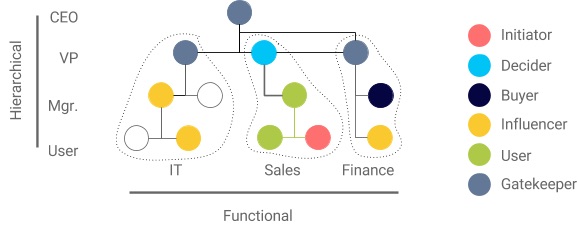
Don’t use industry averages when determining how many accounts each rep should target as part of an account based prospecting approach.
Instead, look at the particulars of your business and calculate what number makes sense for you. Perform two calculations:
- Sales model: How many accounts do you need to hit your target?
- Capacity model: How many accounts can one rep handle?
For each of these calculations, there are trade-offs you need to consider. For example, how wide or how deep to prospect into an account. Once you understand the (simple) formulas, you can make the right trade-offs for your business. Calculate how many accounts to target based on your sales targets (top-down)
Calculate how many accounts to target based on your sales targets (top-down)
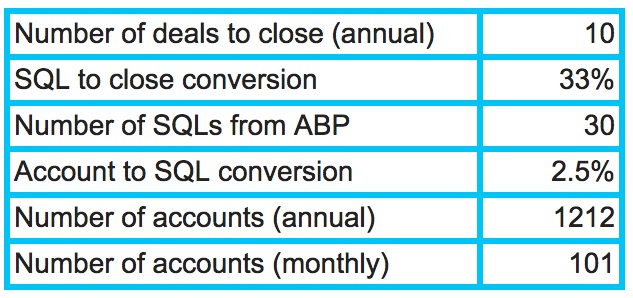
Let’s assume an individual rep needs to close 10 deals per year. If the (industry) average Sales Qualified Lead to Close conversion is 33% (but plug in your actual conversion rate here) then this rep would need to work on 30 SQLs during the year to make their number. In our experience, if you diligently work a cold list of accounts, then the account to SQL conversion is about 2.5%. If your leads are warmer and have already been engaged by marketing, that percentage can be as high as 10%.
If we stick to the 2.5% number — then a rep must start with a cold list of 1,212 accounts a year (or 101 per month) to create those 30 SQLs. You can probably achieve the same conversion rate by touching 606 accounts twice a year as you can from touching 1,212 accounts once every 12 months, which can be useful especially if your (initial) target market is (too) small to support all your reps.
If you are early and you have a big enough market, with more accounts than your reps can handle then it probably makes sense to go wide (meaning: touch every account with just one full cadence each year). Just reaching out to the people, will create market awareness. If you are later stage, your territories get smaller, or your market is just too small to feed all reps, then design a process around executing two to four full cadences against each account during the year. In between the accounts can be nurtured by marketing.
See below some examples of SDRs completing two full cadences against a target account list during the year, with some nurturing in between by marketing, either via email (if the prospects have opted in), or via Facebook Custom Audiences (if they haven’t opted in). More about this strategy in a future blog. The SDR cadences are represented by the black boxes. 11×21 stands for 11 touches over 21 days. The blue boxes are nurture steps that marketing is responsible for.
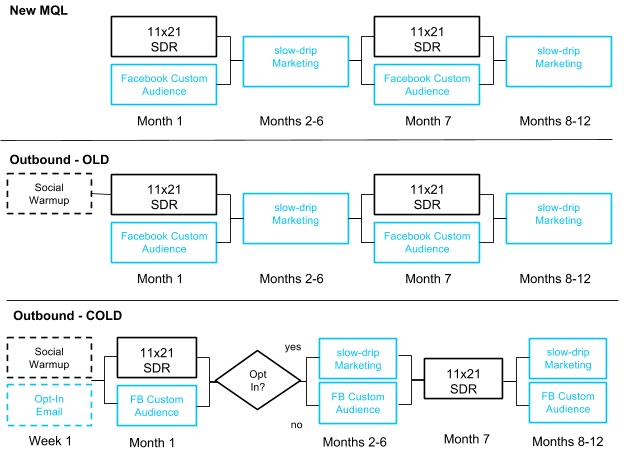
Examples of prospecting accounts with two full SDR cadences each year
Calculate how many accounts to target based on the sales (SDR) capacity that you have (bottoms up)
Now let’s see how many accounts a single rep can actually prospect. This depends on a number of factors, including:
- How many contacts you target in each account (how ‘deep’ to prospect)
- How many touches your reps can do in a single day
I was working with a security company, which was targeting Global 2000 companies. The SDR working on American Express had diligently added all the contacts she found in Salesforce into a cadence targeting American Express. The problem? There were 77 contacts for American Express. Let’s assume your cadence involves 8 touches over the course of a month. That means that American Express alone would take her 616 touches to complete. If she makes about 60 touches (in a combination of email and phone calls) a day that means she could be working on securing a meeting with American Express for well over ten days. If American Express represents a ten million dollar deal for you, that might very well be the right strategy. In many cases however, it is probably better to strike a balance between prospecting wide (many accounts-few contacts per account) and deep (many contacts per account).
Going wide might mean only contacting one contact per account. We call this approach typically content-based outbound, rather than account based prospecting. If you dedicate 100% of your time to outbound/account based prospecting, contact only one contact per account and make 60 touches each day, and touch every account only once a year, then you can prospect into cohorts of 200 new accounts every month or 2,400 accounts each year. If you decide you want to contact each account in your database twice a year (every six months), which we recommend, then you can handle only 1,200 accounts per rep.
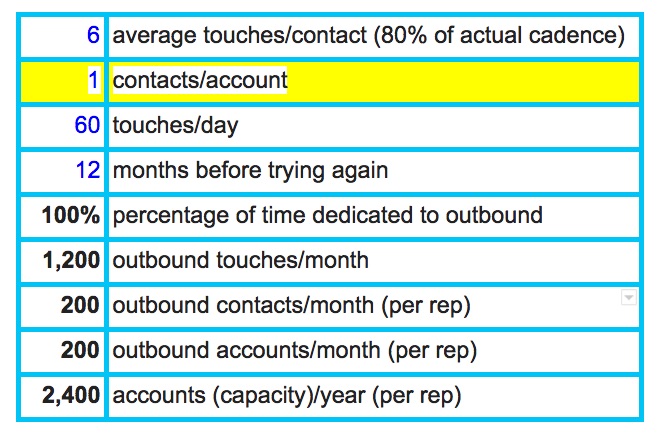
For most account based prospecting, you want to target multiple people in the account. Three (3) to five (5) contacts per account is a pretty good middle-of-the-road target. You might look for 1–2 decision makers (which could be targeted by your AE) and 1–3 initiators (champions) (which could be targeted by your SDR). In the example of the security company, they tried to look for the head of global security or chief security officer and the director of security operations or threat intelligence. It wasn’t always clear from the outside (sources like LinkedIn) who held these two roles in the company so they ended up with about five (5) contacts per company.
While the actual cadence this company used was 8 touches long, for the model we assumed 6 touches since some subset of contacts will be reached before the end of the cadence is reached. Therefore, the assumption was that a rep had to make on average 6 touches per contact targeted. Putting this all together, if you go deeper — with five contacts per account — the rep can now only handle 40 accounts per month and 480 accounts per year.
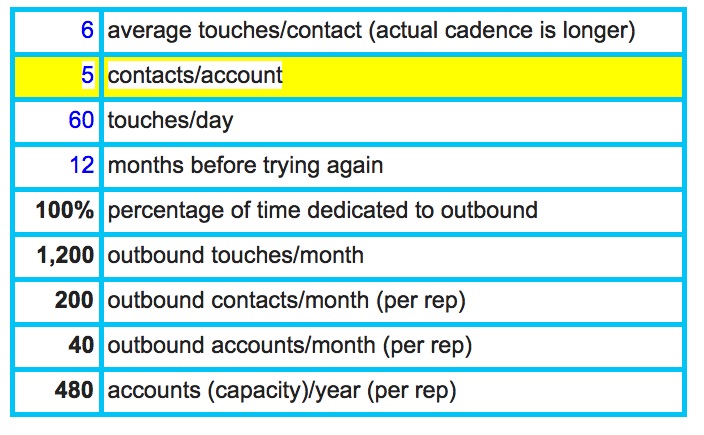
You can play with the trade offs until the model works for you: if you need to cover more ground (accounts) you could:
- Lower the number of touches/contact (calls and emails in your cadence)
- Automate some of the steps in your cadence (personalize less)
- Lower the number of contacts/account
- Increase the number of touches/day
Prospect target accounts in cohorts every month
See below how all these calculations fit together for one particular company. There were close to 30,000 accounts that met their initial target market criteria, but within this there were a subset of about 4,000 accounts with a higher likelihood to buy so these became the initial focus area. This company started with just one SDR who spent only half of his time on the outbound effort. This meant that she could handle just 100 accounts per month. The capacity model showed that with one SDR the company might not make it’s numbers, so the company decided to invest in a second SDR.
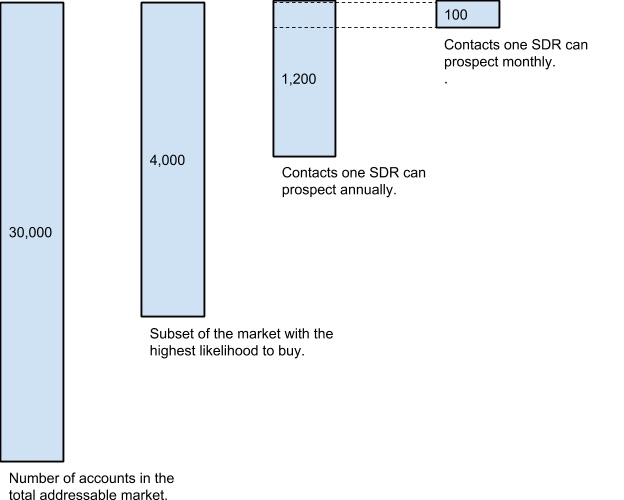
Whatever you do, don’t just look what others are doing in account based prospecting
If there is only one thing to take away from this blog, it is that you shouldn’t blindly follow “industry averages” when it comes to your account based prospecting strategy. How many accounts to target per rep depends on strategic decisions that are specific to your market, product, and situation. I would love to hear from you what trade-offs they have made? I am always open for a discussion on this topic, in the comments, by phone or in person.

